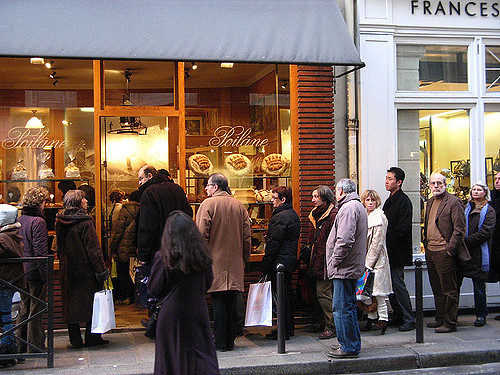Unlock the Magic in Your Story Now
Get the Free 20 questions to Ask Before Launching Your Idea workbook when you sign up for occasional updates.
Get the Free 20 questions to Ask Before Launching Your Idea workbook when you sign up for occasional updates.
Articles filed in: Marketing
The Slow And Steady Advantage
 The salespeople at our local gym usually interact with their customers once. A person who is motivated enough to book a gym tour, followed by the inevitable sales conversation is likely to join. The conversion rate is high. While designing the experience to optimise the quickest route to the sale works for the gym—it’s not a good model for most businesses.
The salespeople at our local gym usually interact with their customers once. A person who is motivated enough to book a gym tour, followed by the inevitable sales conversation is likely to join. The conversion rate is high. While designing the experience to optimise the quickest route to the sale works for the gym—it’s not a good model for most businesses.
Most businesses are sustained by multiple interactions with returning customers over time. Consistent engagement over time adds value, even when it doesn’t end in a sale.
Trust is an invaluable resource.
In our hurry to succeed we sometimes overlook the opportunity to engage first and sell later. Marketing works best when it’s anticipated, and the person on the other side of the interaction feels like they had a hand in the result.
Business is a marathon, not a sprint.
Image by Sue Langford
People Power
filed in Marketing, Storytelling, Strategy
 When a traveller books a $700 a night hotel room she assumes that she’ll have a five-star experience. She’s expecting more than a better bed, thicker carpets and fancier facilities. When a five-star hotel gets a one-star review, it’s an indication that something went badly wrong.
When a traveller books a $700 a night hotel room she assumes that she’ll have a five-star experience. She’s expecting more than a better bed, thicker carpets and fancier facilities. When a five-star hotel gets a one-star review, it’s an indication that something went badly wrong.
Of course, guests and customers are disappointed for a variety of reasons. Reality can’t always meet expectations. Sometimes the room is noisy, or the food is cold. Maybe the shower is dirty, or the bed is uncomfortable. But these issues in isolation rarely result in a ‘terrible’ review.
When you analyse one-star reviews, a clear pattern emerges. It doesn’t matter whether the hotel’s room rate is $700 or $70 a night—every single one-star review is a result of human failure. It’s what happens in the moment when the customer seeks acknowledgement that changes everything.
The best product on the planet is rendered virtually worthless if the person delivering it fails to make a human connection with the customer. We want to be seen more than we want plush carpets beneath our feet or goose down pillows under our heads.
Image by Thomas Hawk
Forget Which Way The Wind Is Blowing
 When the disco diner opened on a warm Summer night in a flurry of pink neon, accompanied by loud music and cheap booze, the owner felt reassured he’d found his tribe. But as the evenings grew shorter and the nights colder, his confidence began to waver. The evolving messaging on a pair of sandwich boards obstructing the pavement outside was a sign that all was not well inside.
When the disco diner opened on a warm Summer night in a flurry of pink neon, accompanied by loud music and cheap booze, the owner felt reassured he’d found his tribe. But as the evenings grew shorter and the nights colder, his confidence began to waver. The evolving messaging on a pair of sandwich boards obstructing the pavement outside was a sign that all was not well inside.
The first board advertised the diner’s happy hour—$5 beers, wine and schooners from 4-7pm. The second advised that the kitchen was vegan-friendly and open until 1 am. An attempt to pick up customers who couldn’t get a table at the popular vegan taco place across the street.
The wind had clearly changed direction. Successful businesses don’t alter their marketing strategy according to which way the wind is blowing. They know who they are and who they’re for. They know what they’re good at and have a plan to be great at it. Successful brands don’t haphazardly take up the slack. They intentionally set out to do something worthy of becoming the chosen one.
Image by P. Monaghan
Better Bridges
filed in Marketing, Storytelling
 The design and layout of a department store are deliberate. The sum of a thousand decisions, choices made to optimise the customer experience and maximise profit. Cosmetics on the ground floor, furniture on the top. The fewer people shopping for big-ticket items invest time ascending six floors. You could argue that the customers who go to the trouble of reaching the top of the store are the most motivated customers in it.
The design and layout of a department store are deliberate. The sum of a thousand decisions, choices made to optimise the customer experience and maximise profit. Cosmetics on the ground floor, furniture on the top. The fewer people shopping for big-ticket items invest time ascending six floors. You could argue that the customers who go to the trouble of reaching the top of the store are the most motivated customers in it.
And yet often the sales conversation that happens when the customer gets there seems haphazard and unplanned. Despite the marketing jargon about sleep systems and orthopaedic grade mattresses, one bed looks like any other. The salesperson’s script is the bridge between confusion and clarity, indecision and conviction, an enquiry and a sale. The questions she asks and story she tells are also a set of choices that should help the customer to get to where he wants to go.
Our job as marketers, teachers and leaders is to build better bridges to enable the right change to happen. We can choose to do it on purpose.
Image by Jo Zimney
The Rise Of The Patient Marketer
 The fact that we’re exposed to thousands of marketing messages every day is old news. Our lives are now designed to mitigate against being interrupted by things we don’t care about and never respond to. And yet, we often fail to acknowledge that the people we want to reach feel the same way. If we’re not in the market for having someone steal our limited time and attention, we can’t expect our prospective customers to be. They’re fast-forwarding, ad blocking, spam filtering, deleting and ignoring what’s irrelevant to them without giving it a second thought.
The fact that we’re exposed to thousands of marketing messages every day is old news. Our lives are now designed to mitigate against being interrupted by things we don’t care about and never respond to. And yet, we often fail to acknowledge that the people we want to reach feel the same way. If we’re not in the market for having someone steal our limited time and attention, we can’t expect our prospective customers to be. They’re fast-forwarding, ad blocking, spam filtering, deleting and ignoring what’s irrelevant to them without giving it a second thought.
The good news is that the people who win in the attention deficit age are the patient marketers. The people who thoughtfully provide value. The companies that are deeply invested in creating lasting change and delivering as well as experiencing joy along the way. The marketers who are not interested in hustling their way to quick wins. The founders who are in business for the long haul.
You no longer have to worry about being the loudest, most visible, best-resourced business.
You’ve got time to take the long way round.
Image by David McAughtry
The First Marketing Myth
 Logic tells us that just because someone is aware of a product or service doesn’t mean they will buy it. We know that people are not short of choices. And yet when it comes to marketing our products and services, we prioritise awareness all the time. Logic goes out the window. We fool ourselves into thinking that attention and awareness inevitably lead to action.
Logic tells us that just because someone is aware of a product or service doesn’t mean they will buy it. We know that people are not short of choices. And yet when it comes to marketing our products and services, we prioritise awareness all the time. Logic goes out the window. We fool ourselves into thinking that attention and awareness inevitably lead to action.
You can buy attention, but trust and belonging are not for sale.
If affinity is the goal. How will you prioritise that?
Image by USAG
What’s Your Customer’s Context?
filed in Marketing, Storytelling
 Yesterday I got chatting to Sarah in the street about the sofa she didn’t buy. Sarah, who has three daughters under the age of seven had been looking for the perfect sofa for ages. When she finally found the perfect one she put down a deposit on it and waited for it to arrive a few weeks later.
Yesterday I got chatting to Sarah in the street about the sofa she didn’t buy. Sarah, who has three daughters under the age of seven had been looking for the perfect sofa for ages. When she finally found the perfect one she put down a deposit on it and waited for it to arrive a few weeks later.
This sofa was $8,000.
The following morning she began to question her decision. ‘What on earth am I doing? I must be crazy to spend this kind of money on a sofa, especially when I have three small children.’ Sarah decided to cancel her order and keep looking. Which is why she was leaning on her gate telling me the story yesterday about the sofa she did buy. The sofa that was $2,200, with linen covers that can all be removed and chucked in the washing machine. The sofa that’s perfect for now.
We get caught up in the story we want our customers to believe. We obsess about finding the perfect words to express the value we create—often forgetting to consider the story the customer tells about what’s right for her.
What’s the story your customer is telling herself?
Image by Donnie Ray Jones
Back To Basics Marketing
 Our neighbours are having the outside of their house painted. It’s an old Victorian property, built in the 1800s with period features and delicate ironwork. I’ve watched the decorators come and go over the past couple of weeks. Seen them taking care to cover the original tiles on the porch, that could so easily be damaged. They’ve arrived on time and worked diligently. Several of the neighbours who’ve passed by have admired their work and asked for their business card.
Our neighbours are having the outside of their house painted. It’s an old Victorian property, built in the 1800s with period features and delicate ironwork. I’ve watched the decorators come and go over the past couple of weeks. Seen them taking care to cover the original tiles on the porch, that could so easily be damaged. They’ve arrived on time and worked diligently. Several of the neighbours who’ve passed by have admired their work and asked for their business card.
I’m sure the decorators have a website, and I’m also pretty confident that they convert more enquires from the top of their ladders than they do from the contact form on their site. Sometimes the opportunity to tell the right story to the right people is hidden in plain sight.
Image by Peter Miller
The Ready And Willing
filed in Marketing, Storytelling
 The sandwich boards positioned on the footpath. Posters pasted inside the bus shelter. A pair of charity fundraisers stationed outside the university. All marketing tactics designed with one goal in mind—to make the product, business or cause more visible.
The sandwich boards positioned on the footpath. Posters pasted inside the bus shelter. A pair of charity fundraisers stationed outside the university. All marketing tactics designed with one goal in mind—to make the product, business or cause more visible.
The reason our marketing falls flat is that the people we want to serve are not interested in our need to be seen or sell. Customers are motivated by their need to be seen and understood. We all are.
The good news is it’s easier to make things people want than it is to make people want things. When you stop trying to get the attention of the casual passer-by, you have more resources to tell your story to the people who are ready to hear it. What do they want from your product or service?
Image by Judy Dean
In Time
 You don’t know for sure that the broccoli at the local organic store was grown sustainably or without pesticides, but you trust that it was and you’re happy to pay more for it. You have no proof that like the label says the bread gluten-free until long after you’ve eaten it, but you don’t question that it is. You haven’t seen beyond the cover of your favourite author’s new book, but that doesn’t stop you pre-ordering it months in advance.
You don’t know for sure that the broccoli at the local organic store was grown sustainably or without pesticides, but you trust that it was and you’re happy to pay more for it. You have no proof that like the label says the bread gluten-free until long after you’ve eaten it, but you don’t question that it is. You haven’t seen beyond the cover of your favourite author’s new book, but that doesn’t stop you pre-ordering it months in advance.
In the absence of all the facts, you have to make a judgement call about trustworthiness.
You believe a story built on promises because you trust that the person or the business is honest, competent and reliable. Trust creates the connection between buyer and seller. And that connection requires patience.
We don’t hustle our way quickly to success—we earn our way there in time.
Image by Zug Zwag